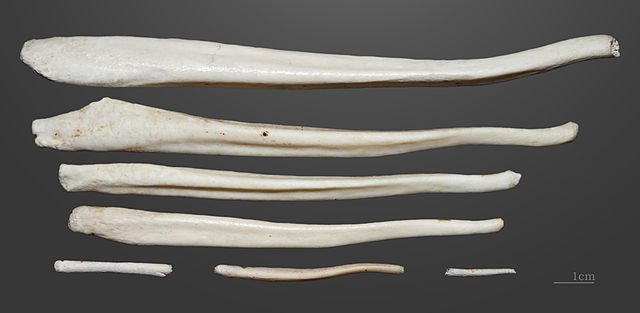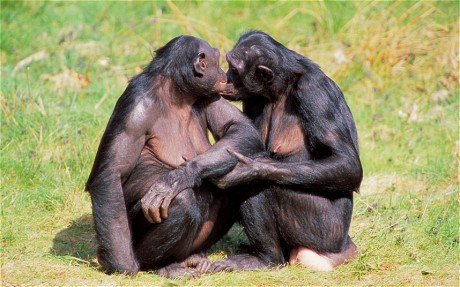Humans don't have a literal penis bone(r), but some primates have literal penis bones. I didn't know that.
Research published December 13th looks into the evolutionary history of the penis bone's evolution and subsequent devolution and loss in some mammals, like humans.

source
The penis bone, or baculum, is an extra-skeletal bone, meaning its not attached to the body, but free-floats at the end of the penis. It varies in shape, size and existence in mammals. It can be a few millimeters long, to a meter long (3 feet), and the shape can be needle-like spines or fork-like prongs. Ouch!
The why and how of its evolution is a mystery. Unlocking another anthropological mystery is something that intrigued anthropologists at University College London (UCL), like Kit Opie and Matilda Brindle who worked on this research. They looked at penis bones from several time periods, and reconstructed an evolutionary trajectory for the mammalian class. They were looking to find out if competition for sexual through intra-sexual selection affected the baculum evolution.

source
Ancestral mammals from way back don't have the baculum, while ancestors of primate and carnivores did. The theory is that the baculum first evolved when placental and nonplacental mammals diverged 145 million years ago, while the most recent primate and carnivore ancestor is more recent at 95 million years.
They also looked at the testes size and penis length which correlates with the higher intra-sexual competition and more sperm, but there is not a clear link between the two. Lastly, the mating pressures and breeding patterns were looked at, and indicated a link between the two. When there are competitive mating systems in place, the baculum was longer. Polygamous and seasonal mating made longer penis bones.
Why does that happen? The baculum would serve to protect the male's penis to assist in fluid transfer for impregnation in the female's cervix, and also prolonged sex, possibly to prevent other mating behavior of the female finding another partner afterwards, and to increase reproductive success of their own seed instead. Intromission duration is important for an animal to genetically succeed, instead of a rival. It's also speculated it served to keep the male spreading the "seed" with multiple females in a short range of time.
The conclusions of the research as to why the baculum is there, range from cats who may need stimulation to produce eggs, or the "vaginal friction hypothesis" where the bone is a shoehorn to squeeze the penis into a female.
It's still early in the research about the weird baculum. What is clear though, is that a species' mating behavior will drive changes in the formation of the baculum. When there are high levels of postcopulatory sexual competition (who's next?), with interchange of polygamous sexual activity frequently, then bigger was better, because it promoted the chances of a female staying with the male longer, and ensuring his seed took hold in an egg.
Since polygamous and frequent mating resulted in a longer penis bone to keep the cervix open, the theory is the bone was dropped by evolution in humans since monogamous sexual behavior doesn't require all the intrasexual competition and "spreading the seed" motivation. Humans have minimal sexual competition compared to other lower consciousness animals, where females typically mate with one male at a time, making the intromission issue less of a concern for human males.

source
Dr. Kit Opie, co-author of the research, says:
"After the human lineage split from chimpanzees and bonobos and our mating system shifted towards monogamy, probably after 2mya, the evolutionary pressures retaining the baculum likely disappeared. This may have been the final nail in the coffin for the already diminished baculum, which was then lost in ancestral humans."
Closing Remark
I'm glad we evolved out of that behavior towards higher consciousness goals and objectives in life, apart from screwing all the time (at least for most of us?) That's why I chose to post this weird news. It shows how we evolved from lower consciousness sex-focused living and behavior, to more trusting, loyal, faithful and cooperative behavior between healthy sexual partners, which fosters more care and compassion for social cooperative success. The drive and focus for sex and pleasure, is a lower consciousness drive and motivator in life, as I have mentioned many times in previous posts. It takes a lot of time, introspection, reflection and analysis to figure out how the subconscious lower consciousness pleasure trap motivation is driving your life.
Thank you for your time and attention! I appreciate the knowledge reaching more people. Take care. Peace.
References:
- Study sheds light on the function of the penis bone in male competition
- Why humans lost their penis bone
- How penis bones help primates win the mating game – and why humans might have lost theirs
- Why the penis bone is the most diverse bone of all
If you appreciate and value the content, please consider:
@krnel
2016-12-12, 8am

